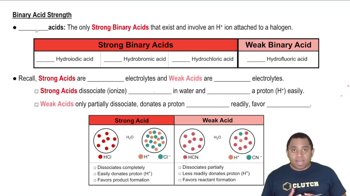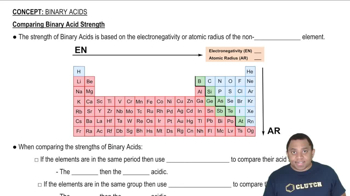Textbook Question
Predict whether aqueous solutions of the following substances are acidic, basic, or neutral: (e) Na2SO3.
 Verified step by step guidance
Verified step by step guidance


Predict whether aqueous solutions of the following substances are acidic, basic, or neutral: (e) Na2SO3.
An unknown salt is either NaF, NaCl, or NaOCl. When 0.050 mol of the salt is dissolved in water to form 0.500 L of solution, the pH of the solution is 8.08. What is the identity of the salt?
An unknown salt is either KBr, NH4Cl, KCN, or K2CO3. If a 0.100 M solution of the salt is neutral, what is the identity of the salt?
Predict the stronger acid in each pair: (c) HBrO3 or HBrO2
Predict the stronger acid in each pair: (e) benzoic acid (C6H5COOH) or phenol (C6H5OH).